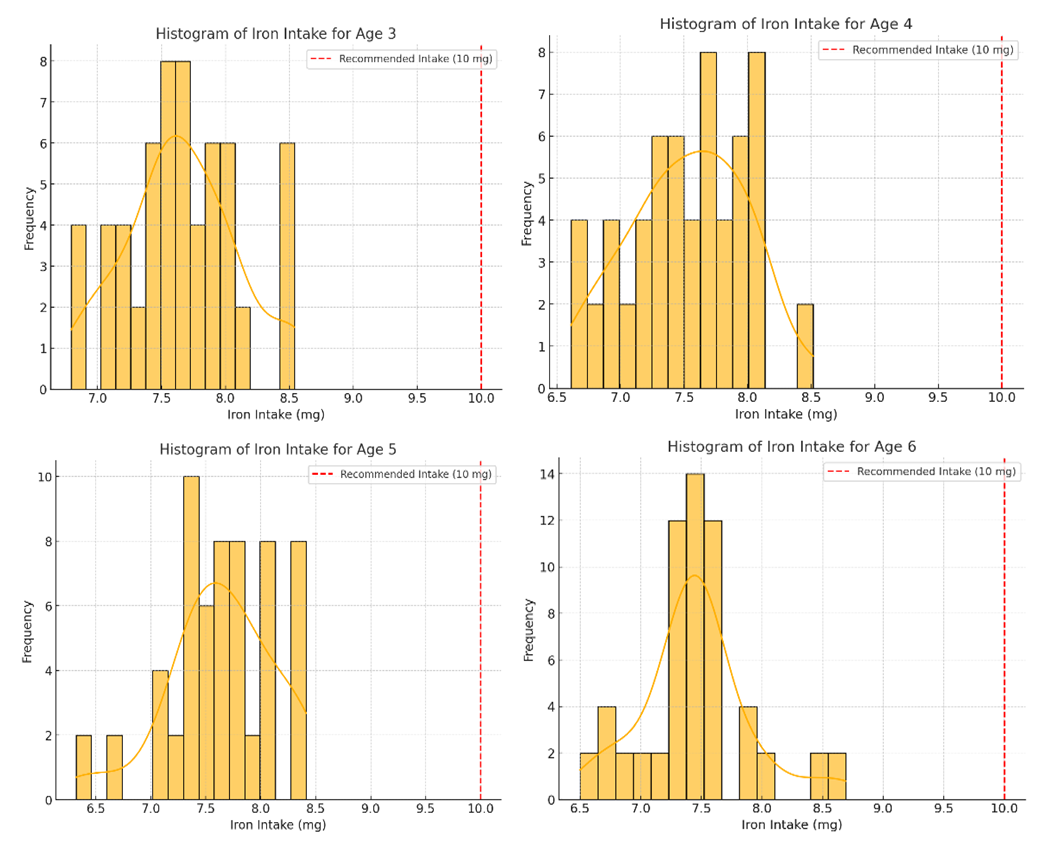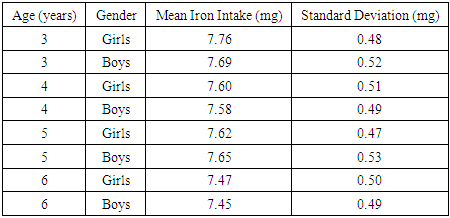-
Paper Information
- Paper Submission
-
Journal Information
- About This Journal
- Editorial Board
- Current Issue
- Archive
- Author Guidelines
- Contact Us
International Journal of Virology and Molecular Biology
p-ISSN: 2163-2219 e-ISSN: 2163-2227
2024; 13(6): 98-101
doi:10.5923/j.ijvmb.20241306.05
Received: Nov. 20, 2024; Accepted: Dec. 10, 2024; Published: Dec. 16, 2024

Results of the Study of Iron Consumption in the Diet of Preschool Children
Mukhayyo Chuliyeva
PhD Student, Department of Physiology, Karshi State University, Karshi, Uzbekistan
Correspondence to: Mukhayyo Chuliyeva, PhD Student, Department of Physiology, Karshi State University, Karshi, Uzbekistan.
| Email: |  |
Copyright © 2024 The Author(s). Published by Scientific & Academic Publishing.
This work is licensed under the Creative Commons Attribution International License (CC BY).
http://creativecommons.org/licenses/by/4.0/

This study investigates the average daily iron intake among children aged 3 to 6 years, segmented by gender, to assess adherence to the recommended daily allowance (RDA) of 10 mg. Statistical analyses revealed that the mean iron intake for all age and gender groups was significantly lower than the RDA (p < 0.01). The findings highlight a widespread iron deficiency among young children, with no significant differences between boys and girls. These results underscore the urgent need for targeted nutritional interventions, including dietary improvements, supplementation programs, and public health strategies to mitigate the risks of iron deficiency during early childhood.
Keywords: Iron intake, Nutritional deficiency, Recommended daily allowance (RDA), Early childhood nutrition, Dietary intervention, Gender differences, Public health, Statistical analysis
Cite this paper: Mukhayyo Chuliyeva, Results of the Study of Iron Consumption in the Diet of Preschool Children, International Journal of Virology and Molecular Biology, Vol. 13 No. 6, 2024, pp. 98-101. doi: 10.5923/j.ijvmb.20241306.05.
1. Introduction
- Iron deficiency and anemia are major public health problems that negatively impact children's development and are relatively common in low-and middle-income countries [1]. Ensuring proper nutrition for the first 1,000 days from pregnancy to 24 months is a key strategy for preventing iron deficiency and anemia, as well as supporting early childhood development [2]. Although iron deficiency, anemia, and risk of development remain high even during the second 1000 days (preschool age 2-5 years), attention to this period remains limited [3,4]. Despite the implementation of various territorial and regional programs in the field of healthy nutrition in our country and abroad, the prevalence of nutrition-related diseases remains high. They manifest in the form of cardiovascular diseases, diabetes, obesity, iron deficiency anemia, osteoporosis, iodine deficiency states, and the presence of micronutrient deficiency [5]. A multi-stage system for monitoring the nutritional status of various population groups has been developed and implemented in the Republic of Uzbekistan. Epidemiological studies on the study of actual nutrition the actual consumption of nutrients and energy in all population groups is lower than normal, indicating a physiological need for these components. This indicates that Uzbek citizens have an excessive amount of fats and simple sugars in their diet, insufficient consumption of minerals, vitamins, and feed fibers. Therefore, the nature and structure of nutrition, the satisfaction of physiological needs in nutrients and energy, is one of the main elements ensuring human health, and the main role in maintaining and strengthening health belongs to the individual themselves, their lifestyle, and eating habits [6]. On the other hand, food can be a source of potentially dangerous substances, among which are anthropogenic pollutants that can lead to the development of carcinogenic and non-carcinogenic effects, which reduce the body's resistance to external negative factors, including harmful ones. This varies depending on the gender and age characteristics of the population [7].The factor of microelement supply is one of the leading components determining children's health. Against the backdrop of increasing micronutrient deficiency, iron deficiency anemia, a non-communicable disease, is increasing in population groups. Iron deficiency remains a global health concern [8].Therefore, iron deficiency anemia is more common than other types of anemia. According to WHO data, iron deficiency anemia among children and women is 10-20% in economically developed countries and 50-60% in developing countries. It is found in some Asian countries up to 90%. Observations of iron deficiency anemia in Uzbekistan over the past 10-15 years have shown that it reaches 25-88% among children and adolescents [9]. Deficiency of iron and other trace elements can affect early brain development through impaired dopaminergic functions, including myelination and monoamine neurotransmission, as well as changes in the structure and function of the hippocampus and prefrontal cortex [10]. This will lead to a decrease in the intellectual development of children in the future. Studies conducted on animals and humans have shown that such early impairments in the structure and function of the brain can negatively impact the cognitive development of children [10,11].Iron deficiency is a major factor in the "hidden nutrition deficiency," which means a lack of essential vitamins and minerals in the diet. iron deficiency affects 340 million children worldwide under the age of five. most importantly, iron deficiency can lead to anemia, which further increases the risk of maternal mortality during childbirth. The shortage of hidden food, especially iron deficiency, is a major concern, as its effects are not immediately noticeable and may be overlooked until the situation deteriorates. This has a significant impact on the health, development, and overall quality of life of children and women.For children, these nutritional problems are part of the "triple burden" of malnutrition, which includes slowing down in growth, weight loss, and obesity. The overall impact of malnutrition affects not only individual health outcomes but also societal development and economic potential.In Uzbekistan, iron deficiency occurs in more than 50% of children under 5 years of age, with regional variations ranging from 39% to 67%. In addition, about 75% of anemia cases in children are associated with iron deficiency [11].Iron in the body depends on children’s diet and absorption from the intestines. The homeostasis of this nutrient is associated with its storage and processing as a reserve. The balance between the release and absorption of iron from cells determines it [12,13,14].The amount of iron in the body depends on children’s diet and absorption from the intestines. The homeostasis of this nutrient is associated with its storage and processing as a reserve. That is it is determined by the balance between the release and absorption of iron from cells.Therefore, studying the full satisfaction of children's iron needs is one of the pressing health problems. The study of this problem is an important stage in assessing the level of iron consumption in children's daily diet and the concentration of iron in their blood. In our study, we studied the amount of iron consumed by preschool children through their actual diet. This study evaluates the average daily iron intake among children aged 3 to 6 years, segmented by age and gender, and compares these values to the recommended daily allowance (RDA) of 10 mg. The goal is to determine if there are significant deviations from the RDA and to assess potential nutritional deficiencies.
2. Materials and Methods
- The study was conducted at the consultative clinic of the Kashkadarya Regional Children's Multidisciplinary Medical Center. Data were collected from a sample of 240 children, evenly divided by gender (120 boys and 120 girls) and age groups (3, 4, 5, and 6 years). For each subgroup, the mean iron intake and standard deviation were calculated. One-sample t-tests were conducted to compare the mean iron intake of each subgroup against the RDA of 10 mg, with a significance level set at 0.01.
3. Results and Discussions
- The data obtained shows that children of preschool age do not consume enough iron in their daily diet. Non-standard iron intake increases the risk of chronic diseases in children in the future (Table1). The analysis yielded the following results:
|
 | Figure 1. The average daily iron intake of preschool children |
4. Conclusions
- The study highlights a significant deficiency in iron intake among children aged 3 to 6 years, underscoring the need for targeted nutritional strategies to ensure optimal growth and development. Addressing this issue is imperative to prevent potential long-term health consequences associated with iron deficiency in early childhood.
 Abstract
Abstract Reference
Reference Full-Text PDF
Full-Text PDF Full-text HTML
Full-text HTML